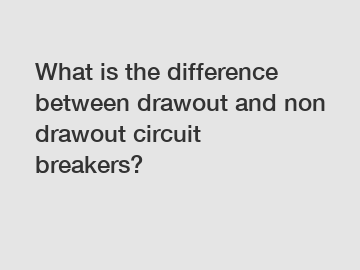What is the difference between drawout and non drawout circuit breakers?
BOKR Product Page
When it comes to circuit breakers, one key difference to be aware of is between drawout and non-drawout circuit breakers. Both types serve the purpose of protecting electrical circuits from overloads and short circuits, but they differ in their design and functionality.
Drawout circuit breakers are designed to be easily removable from the electrical panel or switchgear for maintenance or replacement. They feature a "drawout" mechanism that allows the entire breaker to be pulled out of its housing without the need for extensive disassembly. This makes it convenient for technicians to service the breaker without having to de-energize the entire panel. Drawout circuit breakers are commonly used in industries where downtime needs to be minimized and where regular maintenance is essential.

On the other hand, non-drawout circuit breakers are fixed within the electrical panel or switchgear and cannot be removed without significant effort. These breakers are usually smaller in size and are more commonly found in residential or commercial applications where downtime is less critical. While non-drawout circuit breakers may require more time and effort to replace or maintain, they are often considered more cost-effective for less demanding environments.
In terms of safety, drawout circuit breakers can provide an added layer of protection as they can be easily isolated from the electrical system when being serviced. This reduces the risk of accidental contact with live electrical parts, enhancing the overall safety of maintenance procedures. Non-drawout circuit breakers, on the other hand, may require additional precautions to be taken when working on them to ensure the safety of technicians.
In summary, the main difference between drawout and non-drawout circuit breakers lies in their serviceability and ease of maintenance. Drawout circuit breakers offer greater convenience for maintenance and replacement, especially in industrial settings where uptime is critical. Non-drawout circuit breakers are more commonly used in residential and commercial applications where cost-effectiveness is a key consideration. Both types of circuit breakers serve the same fundamental purpose of protecting electrical circuits, but the choice between them will depend on the specific needs and requirements of the electrical system they are being installed in.
Please visit our website for more information on this topic.
Want more information on power transformer supplier? Feel free to contact us.



